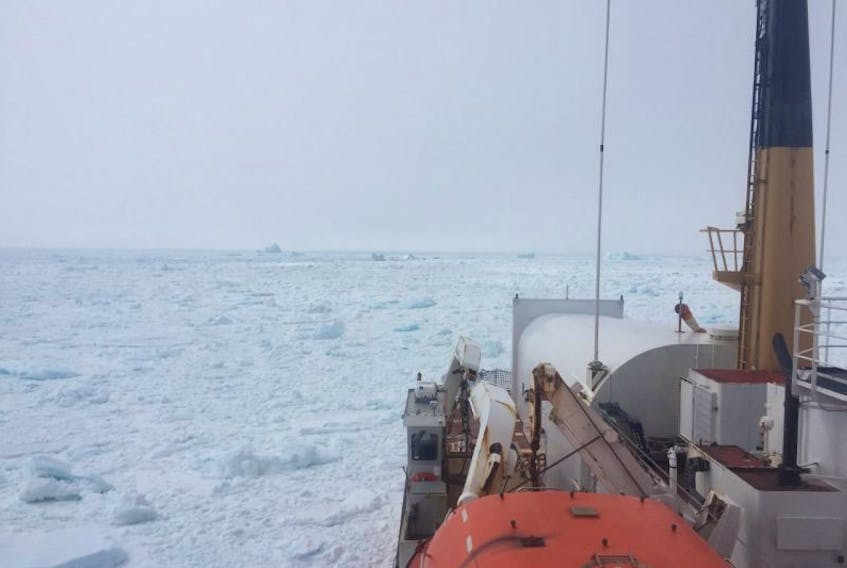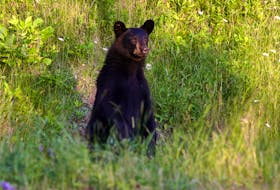Currents, rising temperatures in control of the Arctic
It was Jan. 10, 1914 and Canada’s first great foray into exploring our North had gone horribly wrong.
Three months earlier the Canadian Arctic Expedition’s much-famed organizer Vilhjalmur Stefansson left the retired whaler, The Karluk, with a small crew to hunt for food on Thetis Island.
Capt. Bob Bartlett of Brigus, Newfoundland, who grew to manhood sealing and fishing on the Labrador Coast, pondered the highly detailed note left him by Stefansson.
“You can make all the plans you want in the Far North and write them out on hundreds and hundreds of pages, using all the words in the dictionary,” reads the old sealer’s account in "The Log of Bob Bartlett: The true story of 40 years of seafaring and exploration." “But the finer plan you have the worse it will go to smash when wind and ice and drifting snow take charge. That’s exactly what happened to Stefansson’s plan.”

" … the finer plan you have the worse it will go to smash when wind and ice and drifting snow take charge."
— Capt. Bob Bartlett
Bartlett’s words of warning ring true through to the present as southern Canada begins its rediscovery of the North.
It was not chance that saw a Newfoundland sealer captaining the Karluk.
Before taking the helm of the Karluk for the expedition seeking to explore the Arctic from the west, Bartlett had captained American rear admiral Robert Peary’s missions to the North Pole from the east.
Atlantic Canada’s past and future is intimately intertwined with the North. Our fishermen and sealers continue to hone their hard-won knowledge of how to work in the ice. The Coast Guard’s icebreaker fleet is primarily based on the east coast. The country’s largest research and survey fleet operating in the North, owned by Superport Marine, is based in Port Hawkesbury, Nova Scotia.
But the North is changing and all around us Atlantic Canadians are preparing for the consequent opportunities and the perils.
This series will attempt to look at both.
The Powers that Be
The Arctic is not governed from Ottawa or Moscow or Oslo.
It is ruled by two major currents called the Beaufort Gyre and Transpolar Drift, and the smaller but perhaps more significant one to us, The Labrador Current.
It was the Beaufort Gyre that trapped the Karluk as it spun its great big clockwise circle north of Tuktoyuktuk – slowly compressing its churning ice toward its centre.
“She creaked and groaned and, once or twice, actually sobbed as the water oozed through her seams. There is nothing more human than a ship in ice pressure,” wrote Bartlett of feeling his stout vessel squeezed during the three months the gyre carried it away from the Canadian Arctic toward Siberia.
“The poor old Karluk began to suffer worse than ever . . . Sometimes I used to walk around on the floes out of sight of her because I couldn’t stand to see the way she went on.”

“She creaked and groaned and, once or twice, actually sobbed as the water oozed through her seams. There is nothing more human than a ship in ice pressure.”
— Capt. Bob Bartlett
On the Russian side, the Transpolar Drift is in charge.
The massive wind-driven current collects ice formed north of Siberia and carries it up over the North Pole at a speed of about 1.5 kilometres a day. About four years later the ice is spit out through the Fram Strait between Greenland and the Norwegian Island of Svalbard.
The huge flow of ice has actually opened up the Northeast Passage – a corridor from Europe to Asia via the Russian Arctic – to shipping and oil and gas exploration.
“The Arctic contributes nearly 40 per cent to Russia’s gross domestic product,” said Adam Lajeunesse, the Irving Shipbuilding chair in Arctic marine security who is based at St. Francis Xavier University. “The only thing holding oil and gas back right now in the Russian Arctic is sanctions — they need American technologies.”
The Russian Arctic is a busy, busy place thanks, in large part, to the Transpolar Drift.
Meanwhile in the Canadian Arctic we only get about seven ice free weeks — from Aug. 1 into late September — when ships other than heavy icebreakers can operate in our Arctic.
“The Canadian Arctic will be the last to open up,” said Lejeunesse.
Then there’s the Labrador Current carrying ice and frigid water south between Baffin Island and Greenland down to skirt around the coast of Newfoundland and Nova Scotia.
It not only brings us icebergs but its eternal shoving match with the warm Gulf Stream coming from the south feeds the bloom of microscopic life on the Grand Banks and Scotian Shelf that is the source of our fisheries.
Change
David Barber had a lot of work to do in the Arctic last summer.
The Canada research chair in Arctic systems science at the University of Manitoba was headed north on the 38-year-old CCGS Amundsen to catch the brief navigable summer season in the high Arctic.
At the end of May they ran into heavy ice in the Strait of Belle Isle between Newfoundland and Labrador.
The CCGS Amundsen was reassigned to free fishing boats trapped by the heavy spring ice. Barber and the rest of the scientists had to give up on their hope of making it to the Arctic in 2017.
While a shortage of icebreaking capacity and the growing demands on the Coast Guard by science, industry and private citizens will be addressed later in this series, something else very interesting had ruined Barber’s plans well-laid plans.

“We’ve been losing an area of ice the size of Lake Superior annually for the last 30 years.”
— David Barber, University of Manitoba
At the very top of the world the Beaufort Gyre, Transpolar Drift and Labrador Current had been rubbing their icy shoulders.
“The event we ran into last year was triggered by several of these reversals of the Beaufort Gyre,” said Barber.
Global warming is having a massive impact on the Arctic.
And sometimes it’s messing with the Beaufort Gyre.
Instead of pushing the ice toward its centre and building the same pressure that would eventually crush the Karluk in the early 1900s, the ice is sometimes pushed out.
Some of that ice is squeezed into the Nares Strait between Ellesmere Island and Greenland, where it joins the Labrador Current and comes down toward us.
The irony of global warming for Atlantic Canada is that we will get more ice.
The Arctic is warming at about twice the rate of the rest of the world and all that melting loosens up a whole bunch of ice.
“We’ve been losing an area of ice the size of Lake Superior annually for the last 30 years,” said Barber.
“That can’t go on much longer — we’re in transition from a multi-year ice system to a single-year ice system.”
The old Arctic ice that breaks free each spring and is sent south by the Labrador Current can be hundreds or thousands of years old and it is hard as concrete.
Ask any sealer or shrimp fisherman from northern Newfoundland or southern Labrador what that kind of ice will do to their boats and you’ll get a quick answer.
Meanwhile, glaciers in Greenland and Ellesmere Island are also slowly pouring their frozen masses into the Labrador Current.
When that ice comes south, some of it heads through the Strait of Belle Isle into the Gulf of St. Lawrence and some of it is carried east around St. John’s.
Not only does it pose a hazard to navigation, as it melts, it cools the water off our shores and can make winter stretch further into spring.
Dealing with it
The Canadian Arctic Expedition is not so much remembered for Stefansson’s discoveries.
After leaving the Karluk, his small hunting expedition spent four years living off the land and were the first of European descent to discover several islands before returning home in 1918.
Canada’s first big foray into the Arctic became one of its greatest tragedies — of the 28 people who set out on the Karluk, 11 died.
But the expedition is also remembered for Bartlett’s efforts to save the crew and scientists left behind.
What kept everyone from dying was an ability to deal with changing conditions and Bartlett’s profound respect for Inuit knowledge.
On Jan. 10, 1914, Bartlett heard a crack and rushed down to the engine room to see water pouring in.
The Karluk was finally being crushed.

“I could hear the Victrola in the galley sending out the strains of the Funeral March. Pushing my hood back I bared my head and said, ‘Adios, Karluk.’”
— Capt. Bob Bartlett
Over their three months trapped in the ice they had been preparing for this.
The food, dog teams, ammunition and other stores had all been moved to a house constructed on a large nearby icepan. An Inuit woman had been making new boots and repairing clothes.
As the Karluk settled low, Bartlett sat alone, listening to records on a nifty new contrivance called a phonograph, drinking coffee and throwing each album into the ship’s stove at its conclusion.
He saved Chopin’s Funeral March for last.
“I turned and looked at her as she went down by the head into 38 fathoms of water,” wrote Bartlett. “I could hear the Victrola in the galley sending out the strains of the Funeral March. Pushing my hood back I bared my head and said, ‘Adios, Karluk.’”
At first opportunity, Bartlett and an Inuit set off with the dogs across the ice on a treacherous journey to Siberia where they organized a rescue party for those who remained.









